

Compact Muon Solenoid
LHC, CERN
| CMS-HIN-16-008 ; CERN-EP-2017-080 | ||
| Suppression of excited ${\Upsilon} $ states relative to the ground state in PbPb collisions at ${\sqrt{{s_{_{\mathrm{NN}}}}}} = $ 5.02 TeV | ||
| CMS Collaboration | ||
| 19 June 2017 | ||
| Phys. Rev. Lett. 120 (2018) 142301 | ||
| Abstract: The relative yields of $ {\Upsilon} $ mesons produced in pp and PbPb collisions at ${\sqrt{{s_{_{\mathrm{NN}}}}}} = $ 5.02 TeV and reconstructed via the dimuon decay channel are measured using data collected by the CMS experiment. Double ratios are formed by comparing the yields of the excited states, $ {\Upsilon(\mathrm{2S})} $ and $ {\Upsilon(\mathrm{3S})} $, to the ground state, $ {\Upsilon(\mathrm{1S})} $, in both PbPb and pp collisions at the same center-of-mass energy. The double ratios, $ [{\Upsilon(\mathrm{nS})} /{\Upsilon(\mathrm{1S})} ]_{{\mathrm{PbPb}} }/ [{\Upsilon(\mathrm{nS})} /{\Upsilon(\mathrm{1S})} ]_{pp}$, are measured to be 0.308 $\pm$ 0.055 (stat) $\pm$ 0.019 (syst) for the $ {\Upsilon(\mathrm{2S})} $ and less than 0.26 at 95% confidence level for the $ {\Upsilon(\mathrm{3S})} $. No significant $ {\Upsilon(\mathrm{3S})} $ signal is found in the PbPb data. The double ratios are studied as a function of collision centrality, as well as dimuon transverse momentum and rapidity. No significant dependencies are observed. | ||
| Links: e-print arXiv:1706.05984 [hep-ex] (PDF) ; CDS record ; inSPIRE record ; HepData record ; CADI line (restricted) ; | ||
| Figures | |
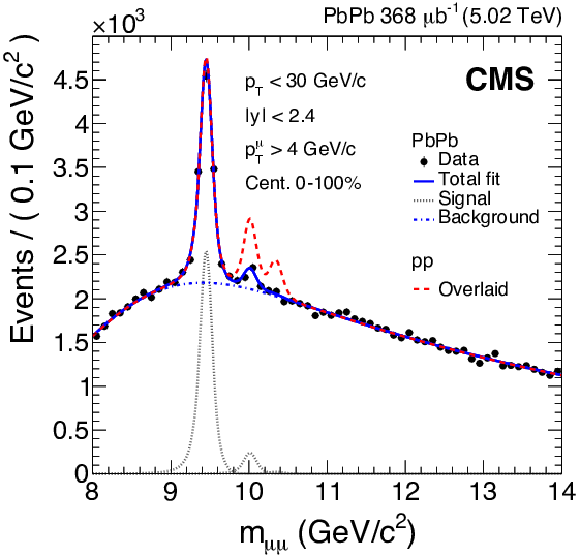
png pdf |
Figure 1:
Measured dimuon invariant mass distributions in PbPb data. The total fit (solid blue line) and the background component (dot-dashed blue line) are also shown, as are the individual $ {\Upsilon (\mathrm {1S})} $, $ {\Upsilon (\mathrm {2S})} $, and $ {\Upsilon (\mathrm {3S})} $ signal shapes (dotted gray lines). The dashed red line represents the pp signal shape added to the PbPb background and normalized to the $ {\Upsilon (\mathrm {1S})} $ mass peak in PbPb. |
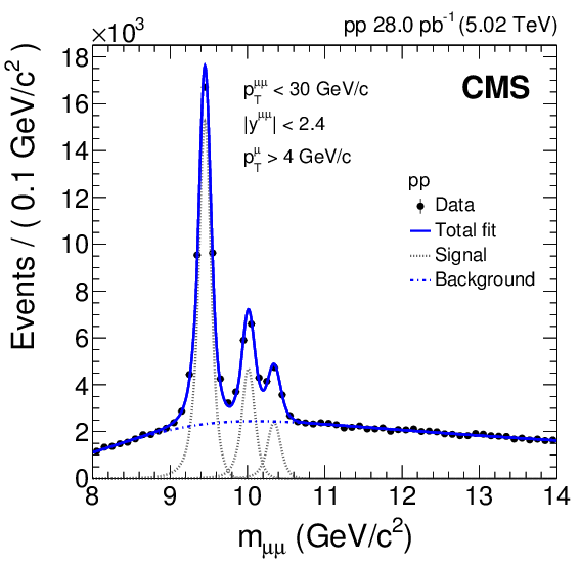
png pdf |
Figure 1-a:
Measured dimuon invariant mass distributions in PbPb data. The total fit (solid blue line) and the background component (dot-dashed blue line) are also shown, as are the individual $ {\Upsilon (\mathrm {1S})} $, $ {\Upsilon (\mathrm {2S})} $, and $ {\Upsilon (\mathrm {3S})} $ signal shapes (dotted gray lines). The dashed red line represents the pp signal shape added to the PbPb background and normalized to the $ {\Upsilon (\mathrm {1S})} $ mass peak in PbPb. |
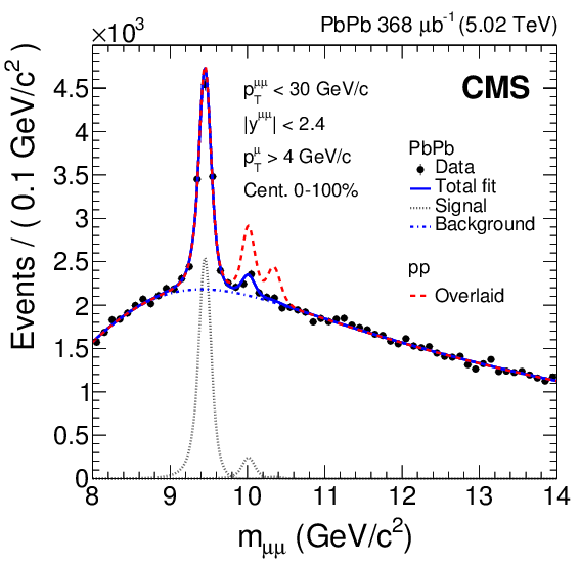
png pdf |
Figure 1-b:
Measured dimuon invariant mass distributions in PbPb data. The total fit (solid blue line) and the background component (dot-dashed blue line) are also shown, as are the individual $ {\Upsilon (\mathrm {1S})} $, $ {\Upsilon (\mathrm {2S})} $, and $ {\Upsilon (\mathrm {3S})} $ signal shapes (dotted gray lines). The dashed red line represents the pp signal shape added to the PbPb background and normalized to the $ {\Upsilon (\mathrm {1S})} $ mass peak in PbPb. |

png pdf |
Figure 2:
Double ratio of the $ {\Upsilon (\mathrm {2S})} $ as a function of centrality. The centrality-integrated value is shown in the right panel. The error bars represent the statistical uncertainty in the PbPb data while the boxes represent the systematic uncertainty due to signal and background variations. The box drawn around the line at unity depicts the systematic and statistical uncertainties from pp data, as well as the systematic uncertainties due to the combined detection efficiency; it is 3.1% and applies to all measurements (including the centrality-integrated one). Calculations by Krouppa and Strickland (orange curves [21]) and by Emerick, Zhao, and Rapp (green hatched band [35]) are also shown. |

png pdf |
Figure 3:
Double ratio of the $ {\Upsilon (\mathrm {2S})} $ as functions of $ {p_{\mathrm {T}}} ^{\mu \mu }$ (left) and $|y^{\mu \mu }|$ (right). The error bars depict the statistical uncertainty while the boxes represent the systematic uncertainties in the signal and background models as well as the combined detection efficiency. Calculations by Krouppa and Strickland (orange curves [21]) and by Emerick, Zhao, and Rapp (green hatched band [35]) are also shown. |
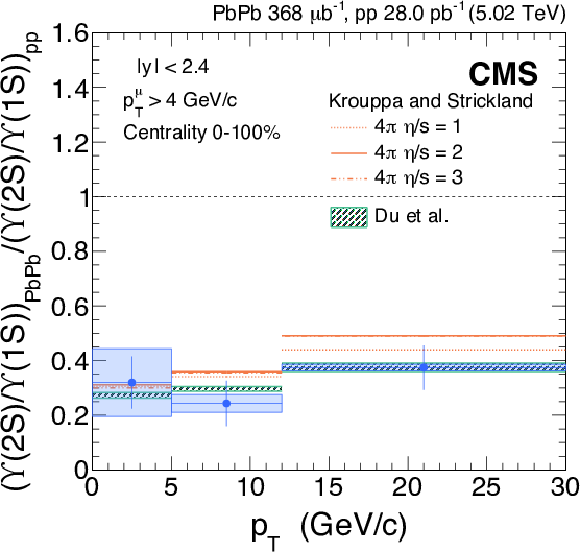
png pdf |
Figure 3-a:
Double ratio of the $ {\Upsilon (\mathrm {2S})} $ as functions of $ {p_{\mathrm {T}}} ^{\mu \mu }$. The error bars depict the statistical uncertainty while the boxes represent the systematic uncertainties in the signal and background models as well as the combined detection efficiency. Calculations by Krouppa and Strickland (orange curves [21]) and by Emerick, Zhao, and Rapp (green hatched band [35]) are also shown. |

png pdf |
Figure 3-b:
Double ratio of the $ {\Upsilon (\mathrm {2S})} $ as functions of $|y^{\mu \mu }|$. The error bars depict the statistical uncertainty while the boxes represent the systematic uncertainties in the signal and background models as well as the combined detection efficiency. Calculations by Krouppa and Strickland (orange curves [21]) and by Emerick, Zhao, and Rapp (green hatched band [35]) are also shown. |
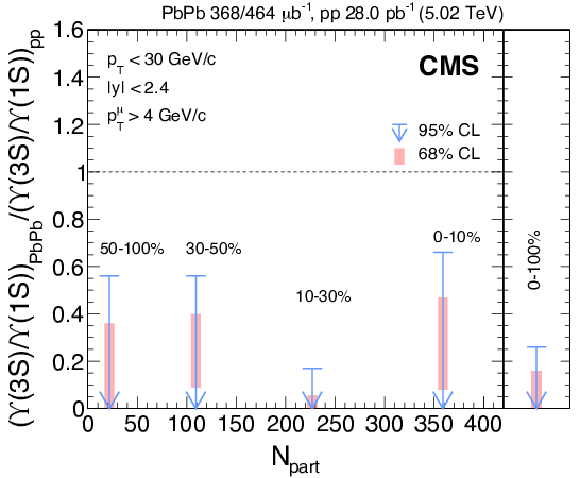
png pdf |
Figure 4:
Confidence intervals at 95% CL (blue arrows) and 68% CL (red boxes) of the $ {\Upsilon (\mathrm {3S})} $ double ratio as a function of centrality. The centrality-integrated limit is shown in the right panel. |
| Summary |
| In summary, the $ \Upsilon(\mathrm{2S}) $ and $ \Upsilon(\mathrm{3S}) $ double ratios have been measured at 5.02 TeV, using pp and PbPb data samples significantly larger than those used in the corresponding 2.76 TeV measurements. The centrality-integrated double ratios are 0.308 $\pm$ 0.055 (stat) $\pm$ 0.019 (syst) for the $ \Upsilon(\mathrm{2S}) $ and $<$0.26 at 95% CL for the $ \Upsilon(\mathrm{3S}) $. The large relative suppression of the $ \Upsilon(\mathrm{2S}) $ does not show significant variations with $p_{\mathrm{T}}^{\mu\mu}$ or $|{y^{\mu\mu}} |$ within the explored phase space window of $p_{\mathrm{T}}^{\mu\mu} < $ 30 GeV/$c^2$ and $|{y^{\mu\mu}}| < $ 2.4. The $ \Upsilon(\mathrm{2S}) $ double ratio is compatible with unity in the most peripheral collisions (70--100%) and with zero in the most central ones (0--5%), but a flat centrality dependence is not excluded, given the current uncertainties. The 95% CL intervals for the $ \Upsilon(\mathrm{3S}) $ double ratio exclude unity in the four centrality bins of this analysis, including the most peripheral collisions (50--100%). |
| References | ||||
| 1 | T. Matsui and H. Satz | $ \mathrm{J}/\psi $ suppression by quark-gluon plasma formation | PLB 178 (1986) 416 | |
| 2 | CMS Collaboration | Indications of suppression of excited $ \varUpsilon $ states in PbPb collisions at $ \sqrt{s_{\rm NN}} = $ 2.76 TeV | PRL 107 (2011) 052302 | CMS-HIN-11-007 1105.4894 |
| 3 | CMS Collaboration | Event activity dependence of Y(nS) production in $ \sqrt{s_{\rm NN}}= $ 5.02 TeV pPb and $ \sqrt{s}= $ 2.76 TeV pp collisions | JHEP 04 (2014) 103 | CMS-HIN-13-003 1312.6300 |
| 4 | CMS Collaboration | Observation of sequential Upsilon suppression in PbPb collisions | PRL 109 (2012) 222301 | CMS-HIN-11-011 1208.2826 |
| 5 | CMS Collaboration | Suppression of $ \Upsilon\text{(1S)} $, $ \Upsilon\text{(2S)} $ and $ \Upsilon\text{(3S)} $ production in PbPb collisions at $ \sqrt{s_{NN}} = $ 2.76 TeV | PLB 770 (2017) 357 | CMS-HIN-15-001 1611.01510 |
| 6 | ALICE Collaboration | Suppression of $ \Upsilon (1S) $ at forward rapidity in Pb-Pb collisions at $ \sqrt{s_{\rm NN}} = $ 2.76 TeV | PLB 738 (2014) 361 | 1405.4493 |
| 7 | STAR Collaboration | Suppression of $ \upsilon $ production in d+Au and Au+Au collisions at $ \sqrt{s_{NN}} = $ 200 GeV | PLB 735 (2014) 127 | 1312.3675 |
| 8 | A. Adare et al. | An upgrade proposal from the PHENIX collaboration | 1501.06197 | |
| 9 | N. Brambilla et al. | Heavy quarkonium: progress, puzzles, and opportunities | EPJC 71 (2011) 1534 | 1010.5827 |
| 10 | A. Andronic et al. | Heavy-flavour and quarkonium production in the LHC era: from proton--proton to heavy-ion collisions | EPJC 76 (2016) 107 | 1506.03981 |
| 11 | S. Digal, P. Petreczky, and H. Satz | Quarkonium feed down and sequential suppression | PRD 64 (2001) 094015 | hep-ph/0106017 |
| 12 | A. Mocsy and P. Petreczky | Color screening melts quarkonium | PRL 99 (2007) 211602 | 0706.2183 |
| 13 | M. Laine, O. Philipsen, P. Romatschke, and M. Tassler | Real-time static potential in hot QCD | JHEP 03 (2007) 054 | hep-ph/0611300 |
| 14 | N. Brambilla, J. Ghiglieri, A. Vairo, and P. Petreczky | Static quark-antiquark pairs at finite temperature | PRD 78 (2008) 014017 | 0804.0993 |
| 15 | A. Dumitru, Y. Guo, and M. Strickland | The imaginary part of the static gluon propagator in an anisotropic (viscous) QCD plasma | PRD 79 (2009) 114003 | 0903.4703 |
| 16 | A. Rothkopf, T. Hatsuda, and S. Sasaki | Complex heavy-quark potential at finite temperature from lattice QCD | PRL 108 (2012) 162001 | 1108.1579 |
| 17 | Y. Burnier, O. Kaczmarek, and A. Rothkopf | Quarkonium at finite temperature: Towards realistic phenomenology from first principles | JHEP 12 (2015) 101 | 1509.07366 |
| 18 | B. Krouppa and M. Strickland | Predictions for bottomonia suppression in 5.023 TeV Pb-Pb collisions | Universe 2 (2016) 16 | 1605.03561 |
| 19 | N. Brambilla, M. A. Escobedo, J. Soto, and A. Vairo | Quarkonium suppression in heavy-ion collisions: an open quantum system approach | PRD 96 (2017), no. 3, 034021 | 1612.07248 |
| 20 | A. Emerick, X. Zhao, and R. Rapp | Bottomonia in the quark-gluon plasma and their production at RHIC and LHC | EPJA 48 (2012) 72 | 1111.6537 |
| 21 | X. Du, R. Rapp, and M. He | Color Screening and Regeneration of Bottomonia at RHIC and the LHC | 1706.08670 | |
| 22 | R. L. Thews, M. Schroedter, and J. Rafelski | Enhanced $ \mathrm{J}/\psi $ production in deconfined quark matter | PRC 63 (2001) 054905 | hep-ph/0007323 |
| 23 | M. I. Gorenstein, A. P. Kostyuk, H. Stoecker, and W. Greiner | Statistical coalescence model with exact charm conservation | PLB 509 (2001) 277 | hep-ph/0010148 |
| 24 | A. Andronic, P. Braun-Munzinger, K. Redlich, and J. Stachel | Evidence for charmonium generation at the phase boundary in ultra-relativistic nuclear collisions | PLB 652 (2007) 259 | nucl-th/0701079 |
| 25 | ALICE Collaboration | Centrality, rapidity and transverse momentum dependence of $ \mathrm{J}/\psi $ suppression in Pb-Pb collisions at $ \sqrt{s_{\rm NN}} = $ 2.76 TeV | PLB 734 (2014) 314 | 1311.0214 |
| 26 | M. Cacciari et al. | Theoretical predictions for charm and bottom production at the LHC | JHEP 10 (2012) 137 | 1205.6344 |
| 27 | CMS Collaboration | Performance of CMS muon reconstruction in pp collision events at $ \sqrt{s}= $ 7 TeV | JINST 7 (2012) P10002 | CMS-MUO-10-004 1206.4071 |
| 28 | CMS Collaboration | The CMS experiment at the CERN LHC | JINST 3 (2008) S08004 | CMS-00-001 |
| 29 | CMS Collaboration | Observation and studies of jet quenching in pbpb collisions at nucleon-nucleon center-of-mass energy = 2.76 TeV | PRC 84 (2011) 024906 | CMS-HIN-10-004 1102.1957 |
| 30 | CMS Collaboration | Dependence on pseudorapidity and on centrality of charged hadron production in PbPb collisions at $ \sqrt{s_{\rm NN}}= $ 2.76 TeV | JHEP 08 (2011) 141 | CMS-HIN-10-001 1107.4800 |
| 31 | C. Loizides, J. Nagle, and P. Steinberg | Improved version of the PHOBOS Glauber Monte Carlo | SoftwareX 1-2 (2015) 13 | 1408.2549 |
| 32 | CMS Collaboration | Charged-particle nuclear modification factors in PbPb and pPb collisions at $ \sqrt{s_{\mathrm{N}\;\mathrm{N}}}= $ 5.02 TeV | JHEP 04 (2017) 039 | CMS-HIN-15-015 1611.01664 |
| 33 | CMS Collaboration | Description and performance of track and primary-vertex reconstruction with the CMS tracker | JINST 9 (2014) P10009 | CMS-TRK-11-001 1405.6569 |
| 34 | M. J. Oreglia | A study of the reactions $\psi' \to \gamma\gamma \psi$ | PhD thesis, Stanford University, 1980 SLAC Report SLAC-R-236, see Appendix D | |
| 35 | Particle Data Group Collaboration | Review of Particle Physics | CPC 40 (2016), no. 10, 100001 | |
| 36 | T. Sjostrand, S. Mrenna, and P. Z. Skands | A brief introduction to PYTHIA 8.1 | CPC 178 (2008) 852 | 0710.3820 |
| 37 | I. P. Lokhtin and A. M. Snigirev | A model of jet quenching in ultrarelativistic heavy ion collisions and high-$ {p_{\mathrm{T}}} $ hadron spectra at RHIC | EPJC 45 (2006) 211 | hep-ph/0506189 |
| 38 | CMS Collaboration | $ \Upsilon(\mathrm{nS}) $ polarizations versus particle multiplicity in pp collisions at $ \sqrt{s} = $ 7 TeV | PLB 761 (2016) 31 | CMS-HIN-15-003 1603.02913 |
| 39 | CMS Collaboration | Measurement of prompt $ \psi $(2S) to $ \mathrm{J}/\psi $ yield ratios in PbPb and pp collisions at $ \sqrt {s_{\rm NN}} = $ 2.76 TeV | PRL 113 (2014) 262301 | CMS-HIN-12-007 1410.1804 |
| 40 | CMS Collaboration | Relative modification of prompt $ {\psi\mathrm{(2s)}} $ and $ \mathrm{J}/\psi $ yields from pp to PbPb collisions at $ \sqrt{s_{\mathrm{NN}}} = $ 5.02 TeV | PRL (2016) , [PRLett.118,162301(2017)] | CMS-HIN-16-004 1611.01438 |
| 41 | G. J. Feldman and R. D. Cousins | A unified approach to the classical statistical analysis of small signals | PRD 57 (1998) 3873 | physics/9711021 |

|
Compact Muon Solenoid LHC, CERN |

|

|

|

|

|

|